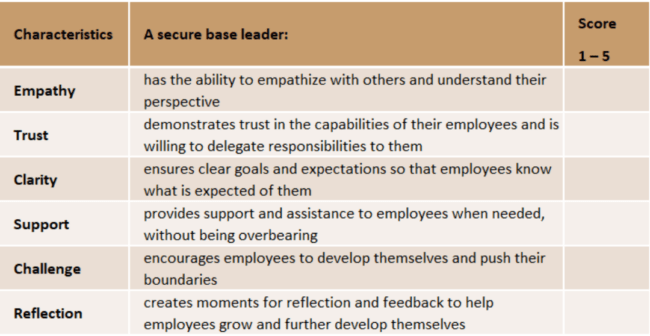
Guiding talent:
5 tips for effective leadership
As a manager, your focus is often on leading projects and meeting deadlines. To successfully complete these projects and meet deadlines, you rely on your team. Unfortunately, people and retention management can consume nearly 60% of your work time. Balancing the success of your team, individual team members, and your own objectives without overworking yourself is a challenge.
Drawing from our 25 years of experience in talent management across various industries and generations, we share five tips for managers to find that balance.
1. Clarity first: define objectives and expectations
Issue
In today’s work environment, many talents struggle with uncertainty about their role or career path. They ponder questions like, “What is expected of me in my current position? Am I performing well enough?” And more importantly, “What are my next steps for growth?” These uncertainties sometimes lead to a lack of direction and motivation. Talents crave clarity and structure in their work. Once they have this, they also seek the freedom and autonomy to independently shape their tasks and responsibilities. Thus, finding a balance between clear guidelines and self-direction is crucial for their engagement and satisfaction in the workplace.

Solution
An effective way to address this need is by establishing a structured and consistent follow-up system. A system used throughout the year focusing on both performance and behavioral objectives.
For instance, define one specific behavioral objective and one performance objective per team member. Record these objectives in a simple, accessible system such as an Excel file. During regular one-on-one discussions, revisit these objectives. It is up to you to share your observations, measure their progress, and determine if there is a need for additional support, such as training or coaching.
This approach not only creates clarity and direction for the talent but also promotes personal development and growth within the organization. The talent feels valued and engaged, strengthening their connection with the organization.
Tip for the busy manager
Don’t do this alone! Ask the junior members to come up with two areas for improvement. Make the talent responsible for their own development. Your role is to support and closely monitor this process.
2. Setting clear agreements builds strong relationships
Issue
A quick message on WhatsApp? A lengthy email? A phone call? Each generation has its own communication style. Whether it’s 7 am or 6 pm, Boomers tend to lean towards phone communication. Gen X and Millennials, on the other hand, prefer emails and WhatsApp, while Gen Z favors modern platforms such as TikTok, Slack, or WhatsApp. This diversity in communication often leads to misunderstandings and inefficiencies, especially when determining the urgency and impact of a message.

Solution
Regardless of generational differences, it’s crucial to establish clear communication agreements within the team. Define specific communication channels for each level of urgency.
- An urgent message with a significant impact on the team or task? Use the phone.
- Is the message less urgent but still relevant? Opt for a message on Microsoft Teams.
- Is the message non-urgent and more informal? Clearly state that WhatsApp is the preferred channel for this.
It’s also important to establish clear agreements regarding communication times if you want to avoid continuous work pressure. We observe that new employees often mimic the behavior of the manager or the team. Early or late messages can create the perception that work pressure is high day and night. However, keep in mind that this may discourage new team members, potentially leading them to not stay long in your team.
Tip for the busy manager
Delegation is the key. Entrust the development of your communication strategy to a dynamic duo within your team. Combine the sharp insights of a Gen Z employee with the experience and wisdom of a seasoned team member. Grant them the freedom to craft a proposal that aligns with the needs of the entire team. This blend ensures a balanced and widely supported communication approach. Additionally, you foster collaboration among team members.
3. People stay for the team (and not the company)
Issue
A company without a clear vision or growth objectives lacks appeal for talents at the early stages of their careers. When young professionals enter the workforce, they are often burdened with less impactful tasks. However, this generation aspires to be part of something bigger and more meaningful. The absence of an inspiring company culture can result in lower engagement at work.

Solution
As a manager, you may not have direct influence over the company’s strategic objectives. Still, you do impact the culture and dynamics within your own team. Defining a team culture – along with communication styles and norms – is crucial.
Ask yourself questions like, “How and when do we celebrate successes? How hard do we work? How do we treat each other?” and make these the core mantras guiding behavior and decision-making in your team.
Examples:
- Collaboratively choose a charitable cause that your team contributes to annually. This enhances the sense of collaboration and social responsibility.
- Organize monthly informal team meetings with snacks and drinks to strengthen team spirit.
- Plan an annual team outing outside the office to improve team dynamics.
Tip for the busy manager
Let your team take the lead in shaping and organizing these activities. Young employees often crave more freedom and responsibility, so they will enthusiastically embrace such projects.
4. The elephant in the room
Issue
Bart’s performance is subpar. Sofie consistently arrives late every Thursday because she goes to the gym first. Or Elke never offers her assistance during team meetings. How do you, as a manager, address these situations? Research indicates that 26% of Gen Z individuals would like more feedback from their managers. It is crucial that you identify and address negative behavior. After all, you wouldn’t want your team to become disheartened if such behavior doesn’t improve, right?
Solution
Effective feedback is factual and based on concrete examples. It’s important to approach the situation without judgment. Describe what you have observed and discuss the impact it has on you or the entire team. After providing feedback, it is crucial to remain silent and observe how the employee responds to the message.
- If you notice resistance from your team member (e.g., “yes, but…”), reiterate what you observed.
- If the feedback resonates with your team member, the conversation can progress to discussing how the negative behavior or lack of skills can be improved
Tip for the busy manager
Be direct and honest in your feedback, but remain respectful and supportive. This approach is not only necessary for the development of your team members but also creates a culture of openness and trust within the team. This, in turn, encourages an environment where issues are addressed and resolved, leading to a healthier and more productive work environment.
5. Be a manager people will go the extra mile for
Issue
A workplace perceived as unsafe stifles the development of employees from the outset. As a manager, self-reflection is essential. When was the last time you evaluated your own management style? What can you improve, and what new skills do you need to acquire?

Solution
A practical step to assess and improve yourself as a manager is to take the Secure Based Leader test. This test provides a structured way to identify your strengths and areas for improvement as a leader.
Tip for the busy manager
Invest time in your own development as a leader. This is not only beneficial for yourself but also for your team. A manager who consistently improves and is open to feedback becomes a leader that people enjoy working with. By developing yourself, you also inspire your team to do the same.
Take the lead in talent retention
Armed with these valuable insights, you are well-equipped to attract the next generation of talents to your organization. Use these practical tips to motivate, support, and inspire your team, creating a work environment where young talent can thrive!